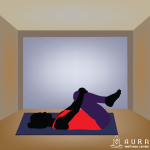Is there a method for teaching inversions and raise the mood of an entire class? Teaching mood elevating Yoga classes, which address and ameliorate the underlying causes of anxiety and depression, are a wonderful way to uplift your Yoga students and serve your community. In addition, gearing some of your classes toward reducing negative thought patterns that perpetuate chronic states of depression and anxiety would help your students to transform their lives, both on and off the mat. As a professional Yoga instructor, you will also be carving out a unique niche for yourself in the industry, by offering classes that address both the physiological and psychological causes of low mood states.
The number of people in the United States, who are taking prescription medication for anxiety and depression, has grown enormously over the last twenty years. The reasons for this dramatic increase is multi-faceted and includes the every growing financial pressure that many people feel in the tenuous job market and the lack of community and family cohesiveness. Some of the dramatic rise in the national statistics on mental health disorders may also be due to more clearly defined processes for diagnosing anxiety and depression.
How to Boost Moods
Although a Yoga student’s struggle with anxiety and depression may not be immediately visible on an external level, when you take time to speak individually to your students, you will quickly be able to identify the students who would most benefit from a Yoga class that is tailored towards elevating their emotional state and patterns of thinking. Additionally, a balanced and challenging mood elevating Yoga class will include asanas and pranayama techniques that will both energize and calm the body-mind complex.
Some of the most effective Yoga postures for boosting one’s mood are inversions. Inversions are defined as any asanas where the head is below the heart. Inversions offer Yoga students a number of important health benefits, including increasing the functioning of the immune system, by increasing the flow of lymph through the lymphatic system. Inversions also help to improve cognitive abilities, such as memory and concentration, by improving the circulation of fresh blood and oxygen throughout the brain. On a psychological level, inversions help a Yoga student to see the world from a new perspective by turning his or her world upside down!
Teaching Inversions For Self-Confidence
These postures also build a student’s confidence when a challenging posture is mastered, such as Forearm Balance. On the other hand, when a posture proves to be too challenging, inverted poses can provide an opportunity for a student to accept his or her current limitations and to ask for assistance and guidance when it is need. How a student deals with a challenging situation during a Yoga class provides an opportunity for the student to witness his or her own negative thinking patterns. This provides a student with a window of opportunity to replace dimming thoughts with more uplifting and optimistic beliefs about his or her ability to overcome challenging situations, both on and off the Yoga mat.
Most inverted Yoga postures also help to increase upper body strength and improve the ability to balance. Some well-known inversions are Headstand, Handstand and Forearm Balance. However, these inversions may prove to be too challenging for many of your beginning or beginning-to-intermediate Yoga students. There are a number of other half inversions that offer many of the same benefits as full inversions, such as Headstand and Handstand, without being fully inverted. These half inversions include Downward Facing Dog, Legs Up the Wall Pose, Dead Bug Pose, and Dolphin Pose.
Dolphin Pose is a very effective half inversion for improving circulation, increasing core stability and building upper body strength. Dolphin Pose also helps to release tension in the upper back, arms and neck. Additionally, this accessible half inversion posture elongates the hamstring muscles and Achilles tendons, which helps to prevent injury during other athletic activities, such as running or tennis. Dolphin Pose also prepares Yoga students for more challenging full inversions “off the wall.” Dolphin Pose is usually practiced after a series of warming Sun Salutations and is frequently linked together is a flowing manner with Cobra Pose or Upward Facing Dog, which helps to dramatically improve arm, upper body and core strength.
Virginia Iversen, M.Ed, has been practicing and studying the art of Yoga for over twenty years. She lives in Woodstock, New York, where she specializes in writing customized articles that are 100% unique. She is currently accepting Yoga and health-related writing orders and may be contacted at: enchantress108@gmail.com.
© Copyright – Virginia Iversen / Aura Wellness Center – Publications Division
See our testimonials to find out what our graduates have to say about our selection of online yoga teacher certification courses.
Please feel free to share our posts with your friends, colleagues, and favorite social media networks.


A balanced and challenging mood elevating Yoga class will include asanas and pranayama techniques that will both energize and calm the body-mind complex. Thanks for sharing this valuable article.
It was nice reading your blog. I always learn new things from your article. Thanks.
[…] decisions require critical thinking skills, and awareness calls for objectivity and clarity. Unrealistic expectations and […]